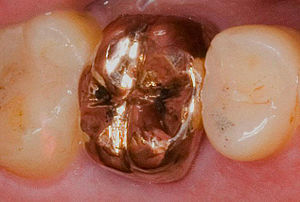Gold Fillings
Gold as a filling material has been known 'for a very long time. Already in ancient Egypt, people used it to fill the space after the removal of tooth decay, which was revealed by the findings of gold in the mouths of mummies. Today, it is used less and less, so information about its production and application decreases, although its lifespan is around 15-30 years'. This material was often seen as the rarest and most expensive, so only the wealthiest could afford it.[1]
Benefits[edit | edit source]
Gold fillings are characterized by high durability and durability (e.g. when chewing). It is a very popular material mainly due to its ductility'', formability and well polishable surface. The color of gold is also more pleasing to some people than the color of eg silver amalgam. Another advantage is the basic property of gold – does not corrode (it does not change in the oral cavity).[1]
The wear of gold is very similar to the wear of tooth enamel, ie. that the opposing teeth are not damaged too much when in contact with the gold filling. Gold is also very well accepted by our body ("biocompatibility"). It is mainly used for small defects in pits, fissures and necks. [2]
Disadvantages[edit | edit source]
The main disadvantage is of course the price, which is 6-10x higher than amalgam filling. It is because of the material' and very hard work'. It is a non-adhesive material', i.e. that it does not stick to the tooth, therefore the cavity needs to be dissected into the appropriate shape in order for the filling to hold in it. [1]
As a metal, gold conducts heat and cold well, which can be uncomfortable for the wearer. Another disadvantage is its 'softness. A prerequisite for choosing a gold filling is also good oral hygiene and low activity of caries.[2]
If a gold filling is placed right next to an amalgam filling, it can cause sharp pain - a galvanic shock'. This phenomenon is caused by the interaction of saliva and metals, but is very rare. [3]
Gold Alloys[edit | edit source]
In dentistry, two types of gold fillings are known, differing mainly in the number of carats. Their characteristics are not very different.
The first are gold alloys with a high gold content (24 carat). They are resistant to corrosion, stable in color and, thanks to the high gold content, homogeneous'. They are mainly used for small areas with a lower bite frequency and for the repair of tooth crowns.[4]
The second are gold alloys with a low gold content. They contain 14-18 karat gold, making them 'more affordable for more people. They first appeared in the early eighties. Their disadvantage is that "porous castings" can form when the alloys are overheated. They are mainly used for the production of crowns, inlays and onlays.[4]
Alloys with high gold content[edit | edit source]
We recognize two types of gold:
- 1. foil (Goldfoil)
- 2. spongy' (Matgold)
The 'Gold Foil consists of 24 carat rolled gold which is combined in very thin foils (1 μm thick) into a block. A piece is cut out of the individual foils and rolled into a so-called pellet (spherical shape). Cohesion of foils can occur between production and processing, so manufacturers cover the surface of the foils with a layer of ``shielding gas (ammonia). This layer can be removed retroactively over a flame of pure 99% undenatured alcohol. Pellets are prepared before treatment and
kept in special wooden boxes'.
''Sponge gold' is obtained electrolytically in the form of powder, which is subsequently sintered (agglomerated, grouped). By agglomeration, better properties during condensation are achieved (they line up better and do not crumble as much). This gold is used only for making the core of the filling, as it will never reach a sealing and homogenous surface without pores. Therefore, the filling surface must be made of gold foil'.
Sponge gold can easily "crumble", which had to be reduced by various methods. Electrolytically addthe canned gold powder was placed between two layers of foil gold and subsequently sintered (the strips of gold are held together by sponges, resulting in better condensation). This filling is also used to build up the core of the filling, but it still needs to be covered with a layer of gold foil.
In '1966 calcium (0.1 - 0.5%) was added to sponge gold to increase the hardness of the material while maintaining the same workability. Even here, the surface must be covered with gold foil. Of all gold hammered materials, it provides the greatest material hardness.
During processing, the powder can also crumble, which is why wax is added to it. The resulting product is referred to as 'Goldent. Before use, it must be heated over a flame to burn off the wax and other contaminants. Sintering occurs during burning, so it no longer crumbles during processing. Goldent contains "about ten times more gold in one pellet than in gold foil". In addition, the surface no longer needs to be covered with gold foil. The disadvantage is that it is more difficult to process, it is more expensive and pores still form here.
Links[edit | edit source]
References[edit | edit source]
- ↑ a b c Types of Fillings. Aetna [online]. 04/26/2005, 4, [cit. 2012]. Available from WWW: <https://www.colgate.com/app/cp/us/en/oc/information/articles/oral-and-dental-health-basics/checkups-and-dental-procedures/fillings/article /types-of-fillings.cvsp>.
- ↑ a b Orbit club [online]. 13.1.2010 [cit. 2010-03-21]. Gold teeth - a thing of the past? Available from WWW: <https://www.orbitklub.cz/e-zubar/vse-o-zubech/28249-.html>.
- ↑ WebMD: Better Information. Better Health. [online]. 2009 [cit. 2012]. Dental Health and Tooth Fillings. Available from WWW: <https://www.webmd.com/oral-health/guide/dental-health-fillings>.
- ↑ a b KULZER, Heraeus. Dent.cz [online]. 13.5.2009 [cit. 2012]. Dental prostheses.DOC. Available from WWW: <http://dent.cz/navody/Heraeus%20Kulzer/>.
References[edit | edit source]
- HELWIG, Elmar – KLIMEK, Joachim. Záchovná stomatologie a parodontologie. 1. edition. Prague : Grada Publishing, a.s, 1999. pp. 107-140. ISBN 80-247-0311-4.


